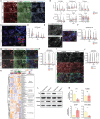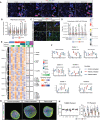Parkinson's Disease Phenotypes in Patient Neuronal Cultures and Brain Organoids Improved by 2-Hydroxypropyl-β-Cyclodextrin Treatment
- PMID: 34637165
- PMCID: PMC9291890
- DOI: 10.1002/mds.28810
Parkinson's Disease Phenotypes in Patient Neuronal Cultures and Brain Organoids Improved by 2-Hydroxypropyl-β-Cyclodextrin Treatment
Abstract
Background: The etiology of Parkinson's disease (PD) is only partially understood despite the fact that environmental causes, risk factors, and specific gene mutations are contributors to the disease. Biallelic mutations in the phosphatase and tensin homolog (PTEN)-induced putative kinase 1 (PINK1) gene involved in mitochondrial homeostasis, vesicle trafficking, and autophagy are sufficient to cause PD.
Objectives: We sought to evaluate the difference between controls' and PINK1 patients' derived neurons in their transition from neuroepithelial stem cells to neurons, allowing us to identify potential pathways to target with repurposed compounds.
Methods: Using two-dimensional and three-dimensional models of patients' derived neurons we recapitulated PD-related phenotypes. We introduced the usage of midbrain organoids for testing compounds. Using Clustered Regularly Interspaced Short Palindromic Repeats (CRISPR)/CRISPR-associated protein 9 (Cas9), we corrected the point mutations of three patients' derived cells. We evaluated the effect of the selected compound in a mouse model.
Results: PD patient-derived cells presented differences in their energetic profile, imbalanced proliferation, apoptosis, mitophagy, and a reduced differentiation efficiency to tyrosine hydroxylase positive (TH+) neurons compared to controls' cells. Correction of a patient's point mutation ameliorated the metabolic properties and neuronal firing rates as well as reversing the differentiation phenotype, and reducing the increased astrocytic levels. Treatment with 2-hydroxypropyl-β-cyclodextrin increased the autophagy and mitophagy capacity of neurons concomitant with an improved dopaminergic differentiation of patient-specific neurons in midbrain organoids and ameliorated neurotoxicity in a mouse model.
Conclusion: We show that treatment with a repurposed compound is sufficient for restoring the impaired dopaminergic differentiation of PD patient-derived cells. © 2021 The Authors. Movement Disorders published by Wiley Periodicals LLC on behalf of International Parkinson and Movement Disorder Society.
Keywords: PINK1; Parkinson's disease; cyclodextrin; isogenics; organoids.
© 2021 The Authors. Movement Disorders published by Wiley Periodicals LLC on behalf of International Parkinson and Movement Disorder Society.
Figures





References
-
- Gammon K. Neurodegenerative disease: brain windfall. Nature 2014;515(7526):299–300. - PubMed
-
- Lozano CS, Tam J, Lozano AM. The changing landscape of surgery for Parkinson's disease. Mov Disord 2018;33(1):36–47. - PubMed
-
- Brás J, Guerreiro R, Hardy J. SnapShot: genetics of Parkinson's disease. Cell 2015;160(3):570. - PubMed
Publication types
MeSH terms
Substances
LinkOut - more resources
Full Text Sources
Other Literature Sources
Medical
Research Materials

